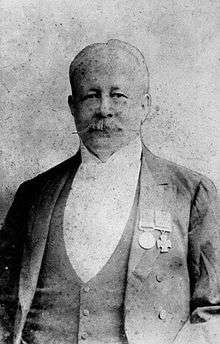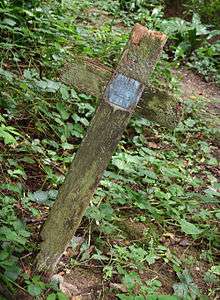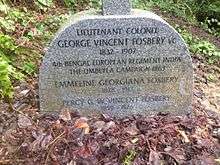George Fosbery
| George Vincent Fosbery | |
|---|---|
 | |
| Born |
11 April 1832 Stert, Wiltshire |
| Died |
8 May 1907 Bath, Bath and North East Somerset |
| Buried at | St Mary's Cemetery, Bath |
| Allegiance |
|
| Service/branch | British Indian Army |
| Years of service | 1852-1877 |
| Rank | Lieutenant Colonel |
| Unit | 4th Bengal European Regiment |
| Battles/wars | Umbeyla Campaign |
| Awards |
|
| Other work | Firearms designer and inventor |
Lieutenant Colonel George Vincent Fosbery VC (11 April 1832 – 8 May 1907) was an English recipient of the Victoria Cross, the highest and most prestigious award for gallantry in the face of the enemy that can be awarded to British and Commonwealth forces. He was also a designer and inventor of firearms.
Military background
An Old Etonian, Fosbery was 31 years old, and a lieutenant in the 4th Bengal European Regiment, British Indian Army during the Umbeyla Campaign during which he was awarded the Victoria Cross. He retired from the service in 1877 having achieved the rank of lieutenant colonel.[1]
Umbeyla Campaign
On 30 October 1863 during the Umbeyla Campaign, North-West India, Lieutenant Fosbery led a party of his regiment to recapture the Crag Picquet, after its garrison had been driven in by the enemy and 60 of them killed. The approach to the Crag was very narrow but the lieutenant led his party with great coolness, and was the first man to gain the top of the Crag from his side of the attack. Subsequently, when the commanding officer was wounded, Lieutenant Fosbery assembled a party and pursued the routed enemy, inflicting on them further losses.[2]
.jpg)

Inventions
In 1895 he patented a design for a self-cocking revolver, which was taken up by the Webley & Scott Revolver & Arms Company. The Webley-Fosbery Automatic Revolver was produced as a six-shot .455 caliber and an eight-shot .38 caliber. It was issued to airmen in the Royal Naval Air Service during the First World War.
Sometime in the late 19th century he invented the Paradox gun.[1] A gun made by Holland & Holland, so named because only the front two inches of the barrel were rifled; intended to be used as both rifle and shotgun, capable of firing both shot and conical bullets with accuracy.
Medals
In 1997, Fosbery's Victoria Cross was sold at an Alberta auction for $45,000. His medals are now on display in the Lord Ashcroft Gallery in the Imperial War Museum in London.[3]
References
- 1 2 "LIEUT. COL. FOSBERY DEAD" (PDF), New York Times, original obituary archived on website, 9 May 1907, retrieved 3 December 2008
- ↑ The London Gazette: no. 22988. p. 3425. 7 July 1865. Retrieved 27 December 2012.
- ↑ "Lord Ashcroft VC collection". Retrieved March 4, 2013.
External links
- Biography
 Recent (March 2016) photo of Fosbery's grave
Recent (March 2016) photo of Fosbery's grave